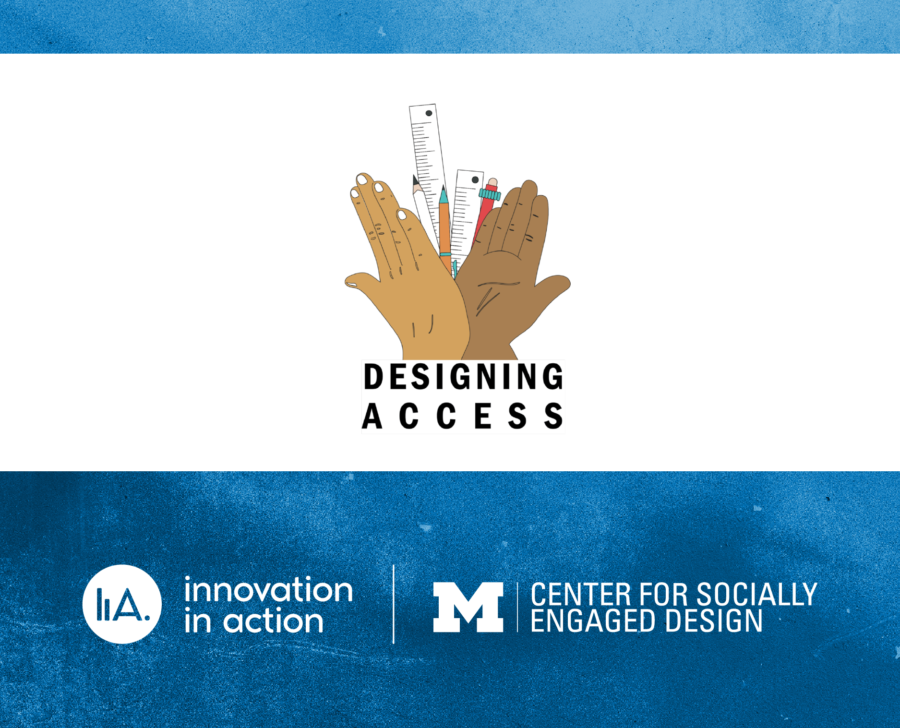Designing Access: A Toolkit for Inclusion
Check out Visionary Central:
Finals Presentation
What’s something you are really passionate about? Imagine there is a meeting about this subject that you want to attend, and you know you could add a meaningful contribution. Now picture the factors that would make it difficult for you to be present: it’s scheduled during work or a religious event, you have a severe food allergy that might make it unsafe to enter the space, or you do not fit the dress code.
Story by Sydney Moore
This powerful scenario serves to put people in the mindset of an attendee, demonstrating the complexity of accessibility. The Designing Access team-Sofie Aaron, Amy Belfer, Callie Torkelson, Hannah Lefton, and Flavio Di Stefano-used this scenario to set the stage for their project: Designing Access, a toolkit for inclusion, consisting of a website and printable pdf.
Problems revolving around accessibility often happen because of a lack of knowledge and intentionality. For instance, after interviewing over fifty stakeholders the Designing Access team found that while all thought inclusion and accessibility were important, only 24% used inclusionary event planning resources. Part of the problem is that resources around this topic are not available in one succinct place. Designing Access wants to change that by spreading knowledge from community for community.
While accessibility holds numerous interpretations, Designing Access defines accessibility to mean that everyone can show up in a space and feel comfortable fully expressing themselves and participating, and that their participation will be welcomed and meaningfully integrated into the space. The team is hoping their website can help provide information and tools in a way that isn’t overwhelming and that helps people think about accessibility more intentionally.
An Intentional Social Justice Lens
The Designing Access team was actually brought together by one of their professors, Katie Doyle. They formed and started thinking about what they wanted to create right around the time that Innovation in Action was recruiting for the 2021 Winter cohort. At the Innovation in Action final showcase, they won the Envisioning an Anti-Racist World award for $1000, a new track focused on the creative potential of working virtually across disciplines and platforms towards inclusivity.

Zoom screenshots of the team members with their various areas of expertise listed below
As social work students, the entire team was able to approach this project with a really intentional social justice lens, which helped them to weave their various experiences into the toolkit. But, there was still a lot of learning involved for the team.
For starters, Designing Access began as a mere class project, and was originally a checklist. However, after talking to stakeholders, the team realized a checklist was not as inclusive as they had originally thought. The format makes accessibility seem like something to achieve, as simple as crossing off boxes as you make your way down the list. Since then, the team has shifted to asking questions, with dropdown menus on their website for more detailed information.
Additionally, the team admitted to not catching certain aspects of accessibility until someone else brought them up, such as childcare. It slipped their minds because none of them have kids, which just goes to show how complex accessibility can be. One member commented, “I think a lot of people immediately jump to wheelchair ramps and other physical space accessibility issues, which definitely exist, but this project really opened my eyes to a lot of other accessibility issues that I’ll be more aware of going forward.”
Growing Designing Access
As Designing Access developed, the team dived straight into the design process. They came to understand that if you want to have a genuine impact you have to take the time to figure out what already exists and then build meaningfully from there. For the team, that meant finding resources about accessible event planning and then using their website to house those resources all in one place. That also meant talking to stakeholders to see what the actual barriers to accessibility were and trying to combat those barriers in sustainable and socially just ways.
To get their project picked up in a systematic way the team looked for leverage points in the ecosystem. This included creating a sustainability plan, with a diagram and suggested prices. Suggested pricing was important to the team because it will allow all people to take advantage of their resources.
Furthermore, a grant majorly facilitated the launch of their website and existing software. Innovation in Action provided necessary guidance and structure along the way. Participating in the program helped the team understand how to work through both their challenge and solution.
That being said, there are limitations to starting in the university space. The team has had to be very intentional about wording, as academia can tend towards buzzwords, but the community isn’t like that. As the team navigated this overlapping space they tried to avoid jargon, acronyms, and language they couldn’t change. This included language around pronouns, which they opted to provide educational materials for instead.

The prototyped website, which starts off broad to ease the user in.
Going forward, the Designing Access team has plans to pilot their program with the School of Social Work. With the pilot, they are going to send out surveys to make sure it is meeting everyone’s needs. They will also be dispersing printed copies of the toolkit at community centers. After that, they plan to sustainably expand to the rest of the campus and then beyond academia.



